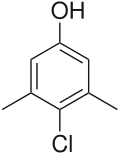Chloroxylenol
Chemical compound commonly used in antiseptics From Wikipedia, the free encyclopedia
Chloroxylenol, also known as para-chloro-meta-xylenol (PCMX), is a chlorine substituted phenol with a white to off-white appearance and a phenolic odor.
 | |
| Names | |
|---|---|
| Preferred IUPAC name
4-Chloro-3,5-dimethylphenol[1] | |
| Other names
para-Chloro-meta-xylenol, PCMX, 4-Chloro-3,5-dimethylphenol | |
| Identifiers | |
3D model (JSmol) |
|
| 1862539 | |
| ChEBI | |
| ChEMBL | |
| ChemSpider | |
| ECHA InfoCard | 100.001.631 |
| EC Number |
|
| KEGG | |
| MeSH | chloroxylenol |
PubChem CID |
|
| RTECS number |
|
| UNII | |
CompTox Dashboard (EPA) |
|
| |
| |
| Properties | |
| C8H9ClO | |
| Molar mass | 156.61 g·mol−1 |
| Melting point | 115 °C (239 °F; 388 K) |
| Boiling point | 246 °C (475 °F; 519 K) |
| 300 mg/L [2] | |
| Solubility in alcohols | soluble |
| Solubility in Ethers | soluble |
| Solubility in Benzene | soluble |
| log P | 3.377 |
| Acidity (pKa) | 9.76 |
| Basicity (pKb) | 4.24 |
| Pharmacology | |
| D08AE05 (WHO) | |
| Hazards | |
| GHS labelling: | |
 | |
| Warning | |
| H302, H315, H317, H319 | |
| P280, P305+P351+P338 | |
Except where otherwise noted, data are given for materials in their standard state (at 25 °C [77 °F], 100 kPa).
| |
The discovery of chloroxylenol was the result of efforts to produce improved antiseptics that began at the end of the 1800s, when scientists gradually realized that more substituted and more lipophilic phenols are less toxic, less irritant and more powerful.[3] First synthesized in Germany in 1923, it was borne out of the study of coal tar components that began a decade earlier.[2]
Synthesis
Other chlorine-substituted phenols are contaminated with dioxins resulting from their synthesis; however, the USEPA found chloroxylenol synthesis was not affected.[4][5]
Uses
Summarize
Perspective
Formulations containing chloroxylenol are used in hospitals and households as antiseptics, disinfectants, and sanitizers. It is commonly used in antibacterial soaps, wound-cleansing, and other household antiseptic applications.[2] Chloroxylenol is used in a number of formulations and under a number of brand names including Dettol.[6]
The World Health Organization lists a 4.8% solution of chloroxylenol as an essential medicine.[7] When diluted, this chloroxylenol preparation is used as an antiseptic and disinfectant, and for skin disinfection. Diluted with alcohol, it is suitable for disinfecting medical instruments.[8]
The use of chloroxylenol has been increasing due to the removal of hexachlorophene[2] and later triclosan and others from world markets.[9][5] It is currently used for control of bacteria, algae, and fungi in:[4][5]
- Adhesive and sealant products
- Construction products
- Lubricant and grease products
- Paint and coating products
- Plastic and polymer products
- Wash tanks
- Diaper pails
- Laundry equipment
- Bedding
- Pet living quarters
- Hospitals
- Personal care products
- Cleaning and furniture care products
- Fabric, textile and leather products
- Ink, toner and colorant products
United States
Chloroxylenol was first introduced to the USA in 1959. Chloroxylenol containing products must not be used in any manner that allows contamination of water.[4]
EU
The European Union allows chloroxylenol in cosmetics up to 0.5%.[5]
Antimicrobial properties
Chloroxylenol is most effective against gram-positive bacteria.[8] It works by disruption of the cell wall and stopping the function of enzymes.[10][11][5] It is less effective than some other available agents.[12][10] Testing has shown products containing chloroxylenol effective against the SARS-CoV-2 virus[13] and orthopoxviruses.[14]
Toxicology
Chloroxylenol is generally slightly to moderately toxic to humans (but causes severe eye irritation), is practically non-toxic to birds, toxic to fish, and moderately toxic to freshwater invertebrates.[4] The European Union considers it to be a skin sensitizer.[9]
Chloroxylenol may also be harmful to smaller vertebrates, especially cats. Phenolic compounds are of particular concern to felines because cats are unable to fully metabolize them. A cat may swallow the product by licking its paws after it has come into contact with it.[15][16] Products containing chloroxylenol such as Dettol have been previously administered with a spray bottle on unwanted pests or invasive species such as cane toads, which die shortly after being sprayed with the phenolic compound. The use of chloroxylenol-containing Dettol as an agent for pest control was banned in Western Australia by the Department of Environment and Conservation in 2011.[17]
Related compounds
- 4-chloro-3-methylphenol (PCMC) – similar use / similar structure
- 2-Chloro-m-cresol – Structural similarity
References
External links
Wikiwand - on
Seamless Wikipedia browsing. On steroids.